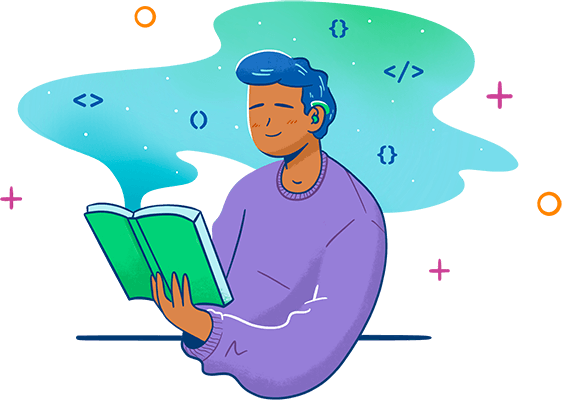Exploring Flask with Peewee
Want to turn your Python programs into web sites and apps? Flask is the little framework that can. With a low barrier to entry, tons of handy packages, and a fast start up, Flask is the go to web framework for many Python developers.
By the end of the track, you'll know the basics of Python, how to install and start using Flask, how to use a database with Python and your Flask app, and more.
We'll begin with some courses in Python fundamentals, including material on Python tuples, sequences, dictionaries, functions, and packing and unpacking. These courses will get you up to speed on the Python language before diving into Flask.
Next, we'll cover front end development basics, like HTML, CSS, and HTTP.
Then, you'll dive full-on into Flask with our Flask Basics course. We'll cover the basics of Git and of using databases in Python, as well.
The next course will have you build a simple social network using Flask. We'll have user registration, user authentication, strongly hashed passwords, form validation, and more.
Finally, we'll walk through REST API basics and building a REST API with Flask using Flask-RESTFul, Flask-Limiter, and Flask-HTTPAuth.
Ready to learn this web framework and start building apps and websites with Python? Let's begin!
Ready to start learning?
Treehouse offers a 7 day free trial for new students. Get access to 1000s of hours of content. Learn to code, land your dream job.
Start Your Free Trial
-
Course
- 1
Introducing Tuples
Learn about a Python data structure that's similar to lists but with one key difference!
-
Course
- 1
- 2
Python Sequences
Discover several types of Python sequences, many ways of sequence iterations, and all of the common sequence operations.
-
Course
- 1
- 2
Introducing Dictionaries
Another useful Python data structure is the dictionary. Learn how to write one and use one in your day-to-day Python code.
-
Course
- 1
- 2
- 3
Functions, Packing, and Unpacking
Learn the ins and outs of Python functions, how to send and receive values to functions, and all about Python packing and unpacking.
-
Course
- 1
- 2
- 3
Introduction to HTML and CSS
Get started creating web pages with HTML and CSS, the basic building blocks of web development. HTML, or HyperText Markup Language, is a standard set of tags you will use to tell the web browser how the content of your web pages and applications are structured. Use CSS, or Cascading Style Sheets, to select HTML tags and tell the browser what your content should look like. Whether you are coding for fun or planning to start a career in web development, learning HTML and CSS is a great place to start.
-
Course
- 1
- 2
HTTP Basics
During this course, we'll look at the underlying method devices use to communicate with each other: HTTP or the HyperText Transfer Protocol. In particular, we'll focus on how a modern web browser automates the sending of HTTP requests and the receiving of HTTP responses.
-
Course
- 1
- 2
- 3
Flask Basics
Flask is one of the easiest ways to bring your Python skills online. It's a great microframework used by thousands of people to create prototypes and small web apps.
-
2 minInstruction
Introduction to Git
A version control system like Git can keep you from losing your work, and help you collaborate with others....(continue reading)
Viewed -
Course
- 1
- 2
- 3
Using Databases in Python
When you want to store data from a program, you have two general choices: files or databases. In this course, we're going to explore using a database from within Python by using the excellent ORM Peewee. We'll build a command line diary application that stores our thoughts and notes in a SQLite database, lets us review and delete them, and even has a search feature!
-
Course
- 1
- 2
- 3
- 4
A Social Network with Flask
It's time to dig in and build something big. In this course, we're going to take the tools we've learned, Flask, Peewee, and Python itself, and build a small social network. We'll have user registration, user authentication, strongly hashed passwords, form validation, and more.
-
Course
- 1
Introduction to REST APIs
Many of the APIs you'll encounter on the Web use an underlying design idea known as REST, which stands for Representational State Transfer. Understanding what and how a REST API provides will help you build better and stronger APIs for your users.
-
Course
- 1
- 2
Flask REST API
Building an API with Flask can be pretty simple but you'll often end up with a large amount of code in just one or two files. In other words, it can be messy! But with a few simple tools like Flask-RESTFul, Flask-Limiter, and Flask-HTTPAuth, you can build a clean, well-organized, and strong API with this great, lightweight Python framework.
-
Track Completion
This course includes:
- Introducing Tuples 13 min
- Python Sequences 65 min
- Introducing Dictionaries 36 min
- Functions, Packing, and Unpacking 65 min
- Introduction to HTML and CSS 2 hours
- HTTP Basics 67 min
- Flask Basics 3 hours
- Introduction to Git 2 min
- Using Databases in Python 118 min
- A Social Network with Flask 4 hours
- Introduction to REST APIs 30 min
- Flask REST API 2 hours